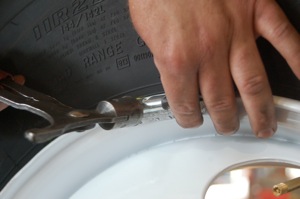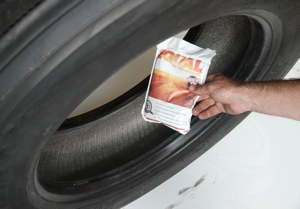Properly balanced tire and wheel assemblies are critical to maximizing final truck tire removal mileages.
Out-of-balance tires will lead to vehicle vibration and driver discomfort. Keeping drivers happy is an important consideration since there continues to be a shortage of qualified drivers.
Irregular wear will increase dramatically when tires are out of balance,out of round, or not running true. With the price of tires continuing to rise, trucking fleets do not want to see their tire budgets go off the charts because of early tire removals.
When there is an unequal distribution of weight around the axis of rotation, a tire/wheel assembly is clearly out of balance. There are really only two options for balancing a tire/wheel assembly. The most common and oldest practice is to add wheel weights attached to the wheel rim flange or other locations on the wheel surface. The other option is to add balancing materials inside the tire.
When it comes to mechanical balancing, a rotating tire/wheel assembly can be balanced externally either statically or dynamically.
If the tire assembly is statically out-of-balance, the result is the tire will be effectively “bouncing” while running down the highway. Every time the bouncing tire lands in a certain spot, it wears fasters there. This, of course, will lead to serious irregular wear and early tire removal. Drivers will not appreciate tires bouncing up and down the highway; that makes for a very unpleasant ride.
Appropriate-sized weights can bring the assembly back into static balance. The industry practice calls for the installation of half the weights on each side of the wheel. This is done to help minimize dynamic imbalance.
The industry recommendation for balance weights on a tire/wheel assembly is a maximum of 16 ounces of weight for steer tires in over-the-road applications. The weight limit increases to 18 ounces for on-/off-road applications. Wide base steer tires have a maximum balance weight recommendation of 24 ounces.
When it comes to drive or trailer axle tire/wheel assemblies, add 4 ounces of weight to the above steer tire balance recommendations.
When a tire/wheel assembly is dynamically out-of-balance, the result is the tire will be wobbling while running down the highway. A tire/wheel assembly that is in dynamic balance is also balanced statically, but the opposite is not true; a tire/wheel assembly that is in balance statically is not necessarily also dynamically balanced.
Balance Methods
The most common procedure to balance a tire/wheel assembly is to use a balancing machine. Some fleets prefer to balance a mounted assembly on the vehicle using a spin-up device and a sensing reader. The advantage of this system is that it allows the technician to troubleshoot truck ride problems due to non-uniformity in other wheel-end components, like the brake drum or rotor.
There are many fleets that add a balance correcting material to the inside of the tire. These materials move freely inside the tire as the assembly is rotating. The advantage is that these materials can also act to reduce vibration – including road shock inputs at the wheel end.
Even after billions of miles of real-world use, fleets still work closely with their tire dealers to ensure that the balancing material will not adversely affect the tire, the casing or future retreadability.
Another option is the use of “balance rings.” These are devices that have a material – liquid or metal balls – enclosed in a ring that is mounted between the brake drum and the wheel. The material moves as the tire/wheel rotates. The theory is that imbalance is reduced as the vehicle is moving by having the material in the ring constantly re-balancing the assembly.
Measuring Runout
Tire/wheel assembly runout is another important consideration when trying to maximize tire removal mileage. Runout is an up-and-down or a side-to-side visible movement when the assembly rotates, and is usually measured using a runout gauge.
There are two types of runout: radial and lateral. Radial runout manifests itself as a changing radius of the rotating assembly. The effect is the vehicle will raise and then lower because the tire has a vertical bounce as it is rotating.
Lateral runout is a side-to-side movement of the rotating assembly. The tire appears to wobble or shimmy as it is rotating, and could cause the vehicle to shift right and left as it travels down the road. A heavy sidewall splice could lead to a lateral runout condition.
Both balance and runout of a tire/wheel assembly may lead to ride and vehicle vibration issues. This then leads to early tire removal and unhappy drivers, who prefer a smooth ride.
Fleets recognize that steer tires that have balance and runout issues are most noticeable to the drivers. As a result, a majority of fleets prefer to mechanically dynamic balance their steer tire/wheel assemblies when they are installed. Drive tires are next in importance, followed by trailers.
Commercial tire dealers need to work closely with their truck fleet customers to ensure they understand the importance of balancing their tire/wheel assemblies to maximize removal miles and reduce/eliminate ride and handling complaints from drivers.
There are truck fleets claiming that keeping tires/wheels balanced and running true down the highway increases removal mileage by 10% to 15%, and even higher. Reducing the onset of irregular wear will not only help tire removal miles, it also will improve fuel economy. With the cost of diesel hovering in the $4.50 per gallon range, maximizing fuel economy is extremely important for every fleet.
Fleets don’t want to see any signs of irregular wear on their tires. They fully understand that fuel economy (money) will drop (lost money) when the tires are bouncing or wobbling (more lost money) as they travel the nation’s highways.













